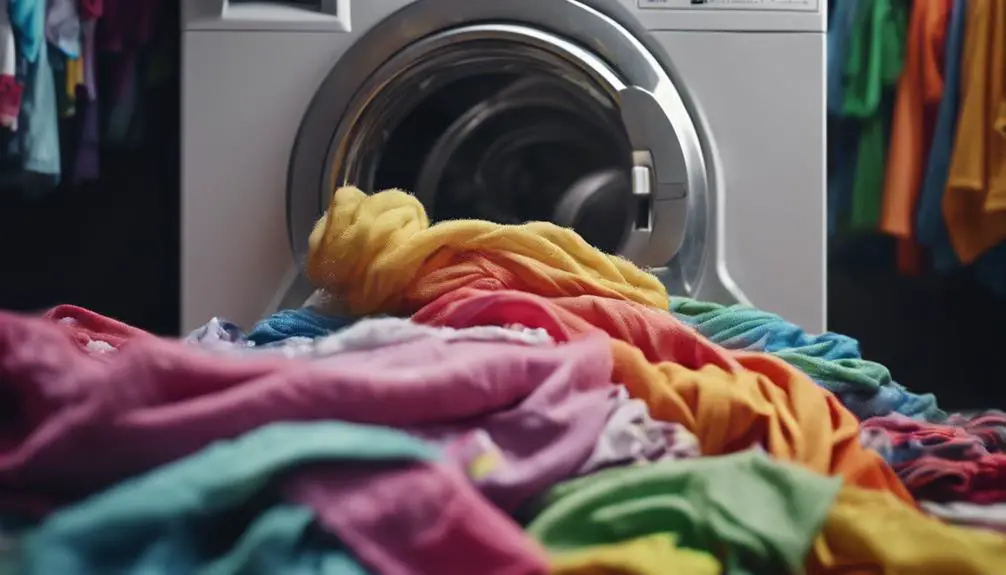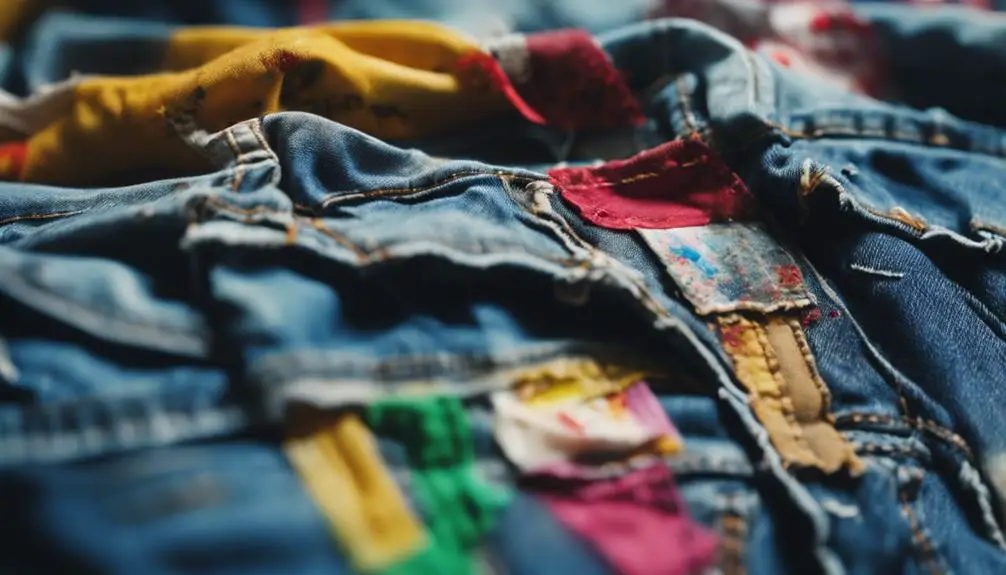To fix shrinkage after washing your clothes, start by soaking the garment in lukewarm water with a gentle detergent for 30 minutes. Avoid rinsing; just gently squeeze out the excess water. Next, roll the item in a towel to absorb moisture and reshape it. For wool fabrics, use steam from an iron while lightly stretching the material back to its original size. You might also try fabric stretching sprays or vinegar solutions for extra help. These steps can revive your favorite wardrobe pieces, and there’s more to explore to maintain their ideal size and shape over time.
Causes of Clothes Shrinkage

Understanding the causes of clothes shrinkage is essential for maintaining your wardrobe. One major factor is the fabric type. Natural fibers like cotton, wool, and linen tend to absorb water, making them particularly susceptible to shrinking. When you wash your garments in high temperatures, the heat causes the fibers to contract, which can lead to a significant reduction in size.
Another critical element is agitation during the washing process. The friction created by your washing machine can tighten the fibers, especially in delicate fabrics, resulting in further shrinking.
Additionally, fabrics are often manufactured under tension. When exposed to water, the yarns relax, and this relaxation can contribute to shrinking when you wash your clothes.
Knowing the specific characteristics of the fabric can help you understand how to prevent unwanted changes in garment size. For instance, if you’re working with natural fibers, consider washing them in cooler water and avoiding high agitation cycles.
Preventing Shrinkage Efforts
To effectively prevent shrinkage in your clothes, always adhere to the care instructions found on garment labels. Following these instructions is essential to avoid shrinking.
When washing, use cold water instead of hot water, as heat is likely to cause shrinkage, especially in natural fibers like cotton and wool. Additionally, washing on gentle cycles can further help avoid relaxation shrinkage.
Make sure not to overcrowd the washing machine. Overcrowding increases agitation and friction, which can lead to more shrinkage during the wash cycle.
If you want to prevent your garments from shrinking, consider air drying instead of using a dryer. The high heat exposure from dryers is a major contributor to fabric shrinkage.
When shopping for new clothes, look for items labeled as pre-shrunk or made from synthetic fibers. These materials tend to be less prone to shrinkage, making them a safer choice for your wardrobe.
Effective Washing Techniques

Preventing shrinkage starts with the right practices, but effective washing techniques are equally important to maintain your clothes’ size and integrity.
To keep your garments looking their best, follow these essential washing tips:
- Always wash your clothes in cold water to prevent fiber contraction.
- Use delicate cycles for fragile fabrics to minimize wear and agitation.
- Place delicate items in mesh laundry bags to protect them from friction.
- Strictly adhere to care tag instructions for ideal washing conditions.
- Avoid high-heat drying methods; opt for air drying or low-heat settings.
Restoring Shrunken Garments
Often, even the most careful washing techniques can lead to unexpected shrinkage in your favorite garments. If you find yourself in this situation, restoring shrunken garments is possible with a few simple steps.
Start by soaking the item in lukewarm water mixed with a gentle detergent for 30 minutes to 1 hour. This process helps relax the fibers, making them more pliable.
After soaking, gently squeeze out the excess water without rinsing, since rinsing can tighten the fibers again.
Next, use the towel roll method: lay the garment flat on a towel, roll it up to absorb moisture, and reshape it to its original dimensions. If you’re working with wool, applying steam from an iron while gently stretching the fabric can effectively coax it back to size.
For additional help, consider using commercial fabric stretching sprays or a vinegar solution to loosen and reshape your garment further.
These methods can restore your favorite pieces, allowing you to enjoy them once more without the worry of shrinkage. Remember, patience is key—take your time to guarantee the best results!
Long-Term Care Practices

Maintaining the longevity of your clothes requires diligence and attention to detail.
To prevent your clothes from shrinking over time, follow these long-term care practices:
- Regularly check care instructions on clothing tags.
- Educate yourself on different fabric types and their specific care requirements.
- Limit the frequency of washing your favorite garments to preserve their integrity.
- Invest in high-quality fabrics known for durability, such as synthetic blends or pre-shrunk cotton.
- Implement a rotation system for frequently worn items to reduce wear and tear.
Frequently Asked Questions
Can Clothes Shrinkage Be Reversed?
Yes, clothes shrinkage can be reversed. You can soak the garment in lukewarm water with baby shampoo or vinegar, gently stretch it, or use professional services for best results. Try these methods to restore your garment’s size.
Is It Possible to Unshrink Clothes?
Yes, you can unshrink clothes! Soak the garment in lukewarm water mixed with gentle detergent for 30 minutes. Gently stretch the fabric while damp, then reshape and dry flat to restore its original size.
How to Stop Clothes From Shrinking When Washing?
To stop clothes from shrinking, always check care labels, wash in cold water, use a gentle cycle, avoid overcrowding the machine, and consider air-drying instead of using a dryer. It makes a big difference!
Is Dryer Shrinkage Permanent?
Yes, dryer shrinkage can be permanent, especially with natural fibers like cotton and wool. High heat causes fibers to interlock or change structure, leading to irreversible size changes. Always follow care instructions to minimize risks.




I don’t think the title of your article matches the content lol. Just kidding, mainly because I had some doubts after reading the article. https://accounts.binance.com/pl/register-person?ref=YY80CKRN